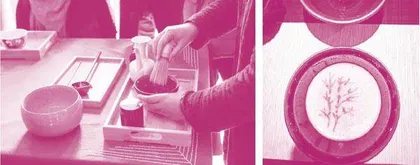Creating Arts in the Tea Cup点茶艺术

You may have seen a barista pour milk foam into a coffee, upon which a beautiful pattern appears. But have you seen the art in a cup of tea?
Dian cha is a tea art from the Song Dynasty. The art begins with pouring water over fine powdered tea, creating a paste and then adding more hot water, constantly whisking it by hand with a bamboo whisk. It is believed that the art later spread to other parts of East Asia, including Japan. In 2019, it was listed as an intangible cultural heritage of Runzhou District, Zhenjiang City, Jiangsu Province.
“It’s like adding bells and whistles to tea and giving people a stronger sense of occasion, so drinking tea is more fun,” said 41-year-old Han Zheming. The Shanghai designer has been fascinated by dian cha since childhood.
“My mother loves traditional culture and I have been leaning toward it under her influence,” said Han.
After he graduated from the China Academy of Art in Zhejiang Province in 2006, Han began his attempt at reviving the art form.
He said during the process of dian cha, the foam resembles paper while the tea paste is like ink. But “drawing” on the tea foam is not easy.
你或许见过咖啡师把奶泡倒进咖啡,在咖啡表面拉出一个美丽的图案。但在茶汤上,你见过这种艺术吗?
点茶是一门起源于宋代的茶艺。首先,将热水倒入优质茶粉中,将其调和成茶膏,然后注入更多热水,手持茶筅不断击打。人们认为点茶技艺后来传播到包括日本在内的东亚其他地区。2019年,点茶被列为江苏省镇江市润州区的非物质文化遗产。
41岁的韩喆明说:“对茶进行艺术加工,可以让人们有更强的仪式感,增加饮茶的趣味。”来自上海的设计师韩喆明从小就对点茶着迷。
韩喆明说:“我母亲是传统文化爱好者,受她的影响,我也踏上了这条道路。”
2006年,韩喆明从位于浙江的中国美术学院毕业后,开始尝试复活点茶这一艺术形式。
韩喆明说,点茶的泡沫类似纸张,而茶膏则像墨水。但在茶汤泡沫上“作画”并不容易。
“When it comes to traditional paintings, it is about the soft brush against the hard paper, but with the tea, it is the other way round,” Han said. “It’s the hard teaspoon against the soft foam.”
Creating patterns on the tea foam is cautious but quick work. Usually, the whole process has to be completed within 10 minutes. The ideal state is when the tea’s temperature is around 40℃ and ready for the palate. It was through trial and error that Han got the hang of dian cha. “Usually, it takes a year of practice for one to fully grasp it,” Han added.
To spread dian cha culture, Han put the process of tea-whisking and drawing on social media platforms, including Xiaohongshu, Bilibili and Douyin, attracting more than 20,000 followers.
Speaking about his understanding of this tea art, Han said it’s “to increase the aesthetics” rather than change the essence of tea.
“As well as poems, calligraphy and paintings that were created back then, I want more people to understand the items used by literati to drink tea, and the reasons behind the ways they prepared tea,” he explained.
“在国画里,用毛笔在纸上作画是‘软碰硬’,但在点茶中刚好相反。”韩喆明说,“用茶勺在松软的茶汤泡沫上作画是‘硬碰软’。”
在茶沫上作画,下笔既需谨慎又要快速。一般来说,从开始点茶到“画作”完成,时间必须控制在10分钟以内。创作的理想条件是茶的温度在40摄氏度左右,刚好可以入口时。韩喆明经过反复试验,终于掌握了点茶的技巧。他补充道:“通常,一个人需要经过一年的练习,才能完全掌握点茶的技艺。”
为了推广点茶文化,韩喆明把点茶作画的过程发布在小红书、哔哩哔哩和抖音等社交媒体上,吸引了超过两万名粉丝。
谈到对这种艺术的理解,韩喆明说,对于茶的艺术加工是为了“提升美感”,而不是取代茶的本质。
韩喆明说:“除了宋代文人在饮茶时留下的诗词、书画作品等,我希望大家可以了解宋代饮茶的器物,以及当时文人为什么要那样玩茶。”
Word Bank
foam /fəʊm/ n. 泡沫
whisk /wɪsk/ v. 搅打,搅动 n. 搅拌器
bells and whistles 华丽的点缀
revive /rɪ'vaɪv/ v. (使)苏醒,复活
The flowers soon revived in water.
get the hang of 找到了诀窍;掌握……的要领
It’s not difficult once you get the hang of it.